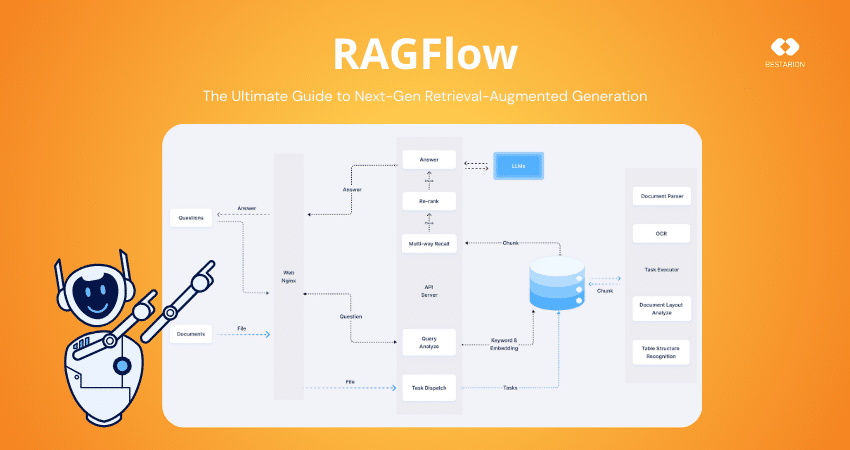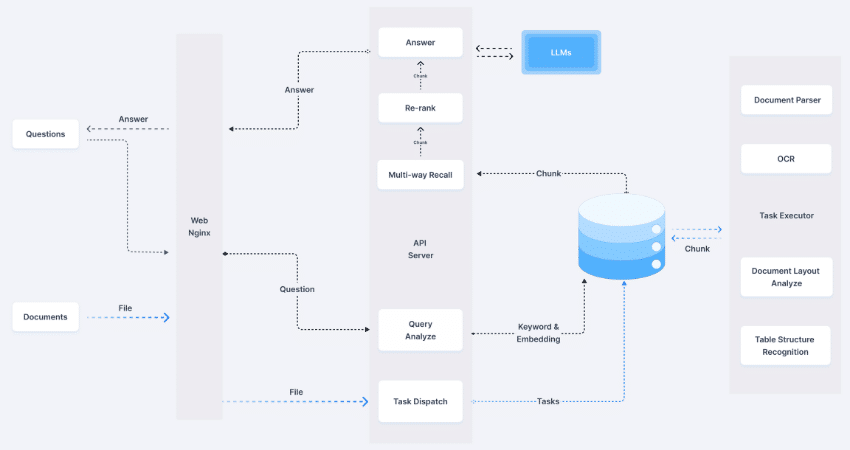RAGFlow Explained: The Ultimate Guide to Next-Gen Retrieval-Augmented Generation

In the rapidly evolving landscape of artificial intelligence (AI) and natural language processing (NLP), the quest for systems that can accurately retrieve and generate information has led to the development of Retrieval-Augmented Generation (RAG) models. Among these, RAGFlow has emerged as a groundbreaking open-source engine that leverages deep document understanding to enhance the capabilities of large language models (LLMs). This comprehensive guide delves into the intricacies of RAGFlow, exploring its architecture, features, applications, and the transformative impact it holds for various industries.
What is RAGFlow?

RAGFlow is an open-source RAG engine designed to streamline the retrieval and generation workflow by integrating deep document understanding with LLMs. Its primary objective is to provide accurate, grounded question-answering capabilities supported by citations from diverse and complex data sources. This integration ensures that the responses generated are not only contextually relevant but also verifiable, addressing a common challenge in AI-generated content—hallucinations or the generation of plausible but incorrect information.
The Evolution of RAG Systems
Traditional RAG systems, often referred to as RAG 1.0, have primarily focused on semantic similarity-based approaches encompassing four stages: document chunking, indexing, retrieval, and generation. While straightforward to implement, these systems have faced limitations:
-
Limited Context Understanding: Difficulty in differentiating tokens requiring increased weight, such as entities or events, leading to poor recall.
-
Inaccurate Retrievals: Challenges in retrieving precise information, especially when user queries involve specific contexts or timeframes.
-
Model Dependence: Performance heavily reliant on the chosen embedding model, which may underperform in specialized domains.
-
Data Chunking Sensitivity: Loss of data semantics and structure due to crude document chunking methods.
-
Ambiguous Query Handling: Inability to effectively manage ambiguous user intents.
-
Complex Query Resolution: Struggles with multi-hop question-answering requiring cross-document reasoning.
Recognizing these challenges, RAGFlow represents the evolution towards RAG 2.0, addressing these limitations through advanced features and a more sophisticated architecture.
System Architecture and Key Features of RAGFlow
1. System Architecture
RAGFlow’s architecture is designed to support its advanced features and ensure scalability and efficiency. The system is divided into several stages:
-
Information Extraction: Utilizes deep document understanding models to process and extract relevant information from unstructured data.
-
Document Preprocessing: Involves knowledge graph construction, document clustering, and domain-specific embedding to prepare data for indexing.
-
Indexing: Employs hybrid search techniques, including full-text search and vector search, to create a comprehensive index of the processed data.
-
Retrieval: Implements coarse and refined ranking mechanisms, along with query rewriting based on user intent recognition, to retrieve the most relevant information.
Each stage is built around AI models that work in conjunction with the database to ensure the effectiveness of the final answers.
2. Key Features
2.1. Deep Document Understanding
RAGFlow employs deep document understanding to extract knowledge from unstructured data with complex formats. This approach ensures that the information ingested into the system maintains its semantic integrity, leading to more accurate and contextually relevant responses.
2.2. Template-Based Chunking
The system offers intelligent and explainable template-based chunking, providing a variety of templates to handle different document structures. This flexibility enhances the system’s ability to process diverse data sources effectively.
2.3. Grounded Citations with Reduced Hallucinations
To combat the issue of hallucinations in AI-generated content, RAGFlow provides visualization of text chunking, allowing for human intervention. It also offers quick access to key references and traceable citations, ensuring that generated answers are well-founded and verifiable.
2.4. Compatibility with Heterogeneous Data Sources
RAGFlow supports a wide range of data formats, including Word documents, slides, Excel files, text, images, scanned copies, structured data, and web pages. This compatibility enables organizations to integrate various data sources seamlessly into the RAGFlow system.
2.5. Automated and Effortless RAG Workflow
The system streamlines RAG orchestration, catering to both personal and large business needs. It offers configurable LLMs and embedding models, multiple recall paired with fused re-ranking, and intuitive APIs for seamless integration with existing business processes.
How to Install and Configure RAGFlow
To set up RAGFlow, follow these steps:
1. Install Required Dependencies
Before you begin, ensure your system meets the following requirements:
-
Docker (Version 24.0.0 or later)
-
Docker Compose (Version 2.26.1 or later)
If Docker is not installed, you can download and install it from Docker’s official website.
2. Clone the RAGFlow Repository
Open your terminal and run the following commands to clone the official RAGFlow repository:
git clone https://github.com/infiniflow/ragflow.git
cd ragflow
3. Start the RAGFlow Server
Navigate to the docker directory and launch RAGFlow using Docker Compose:
This will start the required services in detached mode (-d flag). You can check if the containers are running with:
4. Configure the Language Model (LLM)
Once the server is up and running:
-
Open the RAGFlow web interface in your browser.
-
Navigate to the settings panel and enter API keys for your preferred LLM models (e.g., OpenAI, Hugging Face, or local models).
5. Create and Manage a Knowledge Base
To use RAGFlow for document retrieval:
-
Upload Documents – Add your datasets, PDFs, or text files.
-
Process Data – The system will automatically chunk the data for efficient search and retrieval.
-
Start Querying – Use the RAGFlow interface or API to retrieve relevant information with context-aware responses.
6. Verify Setup and Test Retrieval
To ensure everything is working correctly, run a simple query using the web interface or API. If responses include properly retrieved and referenced information, your setup is complete!
Detailed instructions and commands for each step are available in RAGFlow’s official documentation.
Use Cases and Applications
1. Enterprise Knowledge Management
Organizations can integrate RAGFlow into their knowledge management systems, enabling employees to quickly retrieve relevant information from vast repositories of internal and external data sources. This can significantly improve decision-making processes, reduce time spent searching for information, and enhance overall productivity.
2. Legal and Compliance Research
Legal professionals can utilize RAGFlow for legal document analysis, contract review, and compliance checks. By leveraging deep document understanding, the system can extract clauses, summarize lengthy contracts, and provide citation-backed responses, making legal research more efficient and accurate.
3. Healthcare and Medical Research
RAGFlow can assist medical professionals in retrieving the latest research papers, clinical guidelines, and patient records with precise citations. This ensures that healthcare decisions are based on the most relevant and up-to-date medical knowledge available.
4. Financial Services
In the financial sector, RAGFlow can support risk analysis, fraud detection, and investment research by retrieving and analyzing reports, financial statements, and regulatory documents. It enhances data-driven decision-making by providing verifiable insights.
5. Customer Support Automation
Businesses can integrate RAGFlow into chatbots and virtual assistants to provide customers with accurate, well-cited responses. This reduces dependency on human support agents while improving customer satisfaction through faster and more reliable information retrieval.
6. Academic Research and Education
Students and researchers can use RAGFlow to access a vast array of academic papers, books, and reports, making the research process more streamlined. By providing well-cited references, it also assists in maintaining academic integrity.
Advantages of RAGFlow Over Traditional RAG Systems
Improved Accuracy and Context Awareness
RAGFlow outperforms traditional RAG systems by incorporating deep document understanding, which ensures that retrieved documents maintain their contextual meaning. This reduces errors in retrieval and enhances response accuracy.
Reduced Hallucinations
By offering grounded citations and visualization of text chunking, RAGFlow significantly reduces AI hallucinations. Users can verify generated responses with traceable references, ensuring reliability.
Flexible and Scalable Deployment
With configurable LLMs, multiple recall mechanisms, and seamless integration through APIs, RAGFlow is highly adaptable to various business needs. Its Docker-based deployment makes scaling across different environments straightforward.
Multimodal Data Processing
Unlike many RAG solutions limited to text, RAGFlow supports multimodal data, including images, scanned documents, structured data, and more. This expands its usability across industries dealing with complex data types.
Future Prospects and Enhancements
As AI continues to evolve, RAGFlow is expected to undergo several improvements:
- Enhanced Multilingual Capabilities: Expanding support for more languages to serve a global user base.
- Integration with Real-Time Data Sources: Enabling retrieval from live data streams, news sources, and social media for more up-to-date insights.
- Improved Query Understanding: Leveraging AI advancements to better interpret ambiguous and complex user queries.
- Adaptive Learning Mechanisms: Implementing self-learning algorithms that improve accuracy based on user feedback and interactions.
Conclusion
RAGFlow represents a significant advancement in retrieval-augmented generation technology. By addressing the limitations of traditional RAG systems and incorporating deep document understanding, it sets a new standard for AI-driven information retrieval and generation. Whether in legal, healthcare, finance, or customer support applications, RAGFlow provides a reliable, citation-backed solution that enhances productivity and decision-making.
For those looking to integrate RAGFlow into their workflows, exploring its open-source capabilities and leveraging its modular architecture will be key steps toward harnessing its full potential.


